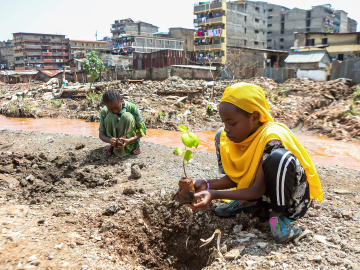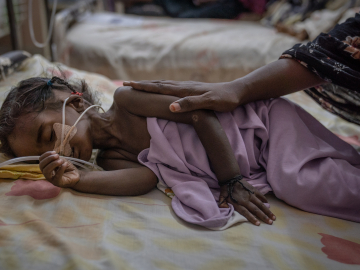Thailand’s Left-Behind Children
UBON RATCHATHANI—Tat looked like any other 8-year-old boy as he sat at a shaded wooden bench, playing with a plastic action figure. As his GI Joe stormed the imaginary positions of his equally imaginary enemies, a portrait of Thailand’s former King Bhumibol Adulyadej gazed down in silent benediction on Tat, his miniature army, and a trio of harried chickens chasing each other through the dust. At first, Tat largely ignored me, unsure what to make of the strange journalist visiting his family’s small farm just outside Ubon Ratchathani, the largest city in eastern Thailand. The economic boom that brought prosperity to the rest of Thailand hadn’t reached this rural agricultural region.
I perched on the bench and began asking Tat questions. Was he looking forward to starting school later in the year? Yes. Did he get along with his 15-year-old brother, Tew? Yes. Did he know where his mommy was? The battle came to a halt and Tat's brows furrowed. No, he whispered, looking away. Do you know your mommy's name, or when you last saw her? Tat just shook his head. Tat’s mother had left Ubon Ratchathani shortly after Tew was born for employment in Bangkok.
Like one-fifth of all Thai children (approximately 3 million in total), Tat and Tew are what social scientists call the “left-behind” children. Since the 1990s, parents have been leaving the rural villages where they grew up and started families for jobs in big cities like Bangkok, leaving their children to be raised by grandparents. A similar phenomenon is happening in China as the country's economic growth has lured young adults from the countryside thousands of miles away to urban centers, leaving 60 million children in the care of their grandparents.
Over the past few years, awareness of the problem has grown across Southeast Asia as researchers have begun to grasp the scope of the problem. The social, psychological, and medical effects on the left-behind children are startling. Children like Tat and Tew are significantly more likely to show developmental delays, along with learning and behavior problems. These issues intensify during adolescence, as Tew experienced, and scientists fear that these issues will follow left-behind children for life. More recently, however, governments and NGOs alike have begun developing interventions to help left-behind children cope, and to reduce the impact of parental separation. It’s still too soon to say whether the potential solutions will be able to counteract such a large-scale problem, but researchers hope it will at least be enough to reduce the impact on kids growing up far away from their parents.
“In countries like China, one-fourth or one-fifth of all children are “left-behind.” That’s a huge population—the backbone of the economy,” says Vancouver-based Iris Cai, who runs an information hub about left-behind children. “With the right guidance, I feel we can turn things around and bring out the strengths of these children.
The economic boom in Thailand and China may have impressed economists, but rising incomes and opportunities arrived unevenly. Growth surged in large cities like Bangkok and Shanghai while rural areas floundered. Many young adults saw no choice but to leave village life to find a job and provide for their families.
Phuttharaksa, Tat and Tew’s mother, never earned quite enough to bring her sons with her. Besides, she told her mother, Buala, she wanted her sons to grow up in the safety of a small town rather than a crowded, polluted megalopolis. Most of the parents in her village made the same choice.
“None of his classmates live with their parents,” Buala says, nodding at Tat.
Buala clearly adores her grandsons, and though they don't have much, they gladly share it with the 2 boys. But with only have an elementary school education themselves, they struggle to connect with their grandchildren as they get older. No matter how fierce their affection, they cannot replace the ever-present strain of Tat and Tew’s absent parents.
“Sometimes I cry at night because I miss my mom,” Tat says.
In 2006, a team of UNICEF researchers began tracking the health of Thailand’s left-behind children. A 2017 report co-authored by social scientist Aree Jampaklay of Bangkok’s Mahidol University found that one-quarter of Thai children living without their parents showed language delays, compared to 17% of children with one or both parents present. They were more likely to be malnourished, reflected in reduced height and low body weight. They were more likely to be victims of physical violence, sometimes from grandparents with outdated views about the acceptability of corporal punishment. Grandparents were less likely to read to their grandchildren, or sing and tell them stories. The problem, UNICEF’s Chris Hirabayashi said, isn’t that most grandparents are deliberately mistreating their grandchildren. It’s that they’re doing the best they can with little money and even fewer resources.
“The grandparents also struggle. Studies have found they have 3 times the rate of mental problems,” he says.
Other studies found that left-behind children encounter a range of psychological difficulties. Girls are more likely to suffer mental ill health, think about suicide, and consider running away. In studies of left-behind children in rural China, researchers found that they were more likely to have difficulties regulating their emotions, experience sexual abuse, attempt suicide, and abuse drugs and alcohol. As these left-behind children become left-behind teenagers, the picture gets even more complicated. Teachers report that children once highly engaged at school (school participation is one of the areas in which left-behind children outperform their classmates) become distant, aggressive, and uncooperative. Since turning 12, Tew has begun clashing more with his grandparents.
“I can’t talk with them about important things,” he says. At his age, girls and acne top the list of concerns he shared with me, difficulties that echo the daily push and pull of forces familiar to all teens. With no parents, Tew instead turns to his friends for help.
What makes the issue of left-behind children so challenging, Hirabayashi says, is the scale of the problem. Along with the large percentage of children in Thailand and China being raised by their grandparents, so are large numbers of young people in the Philippines and Indonesia. Parents and grandparents are doing the best they can in a rapidly changing world, but governments and non-profits aren’t able to keep up.
The problem threatens to become multigenerational. Job prospects in rural areas aren’t improving, says Lianlian Lei, an economist at the University of Rochester in New York who studies left-behind children. With no other model for parenthood, many of the first left-behind children are also migrating themselves, leaving their own children with grandparents.
“When I talk to many of my childhood friends, they are having their own children and then moving away to factory jobs. It’s the only thing they know,” Lei says.
With many of these children just now hitting adulthood, it’s still too soon to say how this will affect the Southeast Asia’s broader social fabric. But a small number of organizations are trying to build resilience and provide support for left-behind children that might help mitigate the problem.
Searching for Solutions
As a researcher, Lianlian Lei worries about the large-scale effects of so many left-behind children. But for Lei, who grew up left-behind in a small village in southwestern China, the issue is also deeply personal. In her youth, her parents both migrated away from their rural home to find work in cities like Shanghai and Hong Kong, leaving Lei with her grandparents. Many of her friends experienced the same sense of loneliness and loss. Still, Lei understands her parents’ choices.
“In a way, I’m a success story. The money from my parents paid for my high school and university in China, and let me, a girl from a small village in China, study in the US,” Lei says.
It’s why Lei is so supportive of work to support families in these situations. To UNICEF’s Chris Hirabayashi, these interventions must begin when parents begin contemplating migration.
“There needs to be more economic support for poor families, and education about good parenting to promote child development, especially in the early formative years. Without this, children might not be able to reach their full potential,” Hirabayashi says.
Part of the problem is that scientists still aren’t sure exactly what the children need and how to provide it, said Jessica Olson, a program manager at the Swedish International Centre for Local Democracy (ICLD). It’s why the ICLD provided funding to pair educators in Huangshan, a town in eastern China with large numbers of left-behind children, with teachers of children in foster care in Sweden’s Vara province. In both locations, children are growing up without their parents, and the 2 sets of educators could learn new strategies to help children cope and stay connected with their families of origin. The project also established after-school centers in Huangshan to provide more adult supervision and social support.
“It let the children acknowledge their sadness and develop tools to better manage their emotions,” Olson says. “Before, they often felt excluded because they didn’t get these tools at home from their own parents.”
Cai, a career coach, has spent the last year trying to raise awareness of the issue in Vancouver’s large Chinese community. Although the Chinese mainland is conscious of the problem via media reports over the past few years, Chinese immigrants living abroad are often unaware of just how many children have been left behind.
“They feel it’s the government’s job to fix and there’s nothing they can do about it,” Cai says. As a result, her information hub for the English-speaking world aims to leverage the fundraising power and charitable consciousness of these individuals.
The Chinese government has begun investing in the development of smartphone apps and other technologies to help migrant parents stay connected to their children. Even without the use of specific apps, the near-universal presence of mobile phones and smartphones provides better opportunities for distant parents to be a part of their children’s lives. Although Tew and Tat may only see their mother in person a few times each year, they frequently talk to her on the phone. Being able to see her as they talked, however, was a rare luxury. Tat’s face lit up when we FaceTimed his mother more than 600 kilometers away in Bangkok. Gone was the shy, mumbling boy who started at the ground while he talked. Instead, he grew animated, telling his mom about the antics of the animals on the farm and the strange journalist and translator who had visited that morning and allowed him to use their phone. Tat’s mother, too, was all grins as she asked stereotypical maternal questions about whether he was being a good boy and whether he had eaten his vegetables. For a few minutes, at least, they were just like any other family.
Join the thousands of subscribers who rely on Global Health NOW summaries and exclusive articles for the latest public health news. Sign up for our free weekday enewsletter, and please share the link with friends and colleagues: http://www.globalhealthnow.org/subscribe.html
iStock




